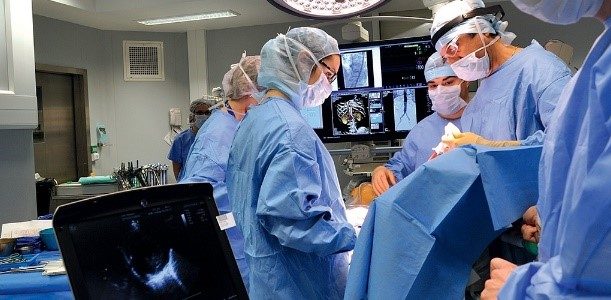Ranked in the top 10 CHUs in France, the Rennes CHU offers a wide range of excellent clinical services, and a state-of-the-art medico-technical platform dedicated to diagnosis and interventional medicine. Every day, the 9 834 professionals, including nearly 915 senior physicians, take up public health issues and offer first-level healthcare. In terms of research and innovation, the CHU is involved in several joint research units for work aimed at improving diagnosis and therapy in the short and medium term. It also participates in larger projects such as those dedicated to improving the flow of information just like the 5G-Tours project.
 Rennes CHU is proud to be part of the H2020 5G-TOURS project and act as vertical for Safe City use cases. We will use the state of the art Millimeter Wave 5G network deployed by Orange in two use cases of Safe City where the focus of the technologies deployed is being at the service of the patients and the rapid care in case of emergencies.
Rennes CHU is proud to be part of the H2020 5G-TOURS project and act as vertical for Safe City use cases. We will use the state of the art Millimeter Wave 5G network deployed by Orange in two use cases of Safe City where the focus of the technologies deployed is being at the service of the patients and the rapid care in case of emergencies.
The use case “Wireless operating room” aims at delivering a new paradigm for operating theatre usage, including Augmented Assisted Surgery, synchronous multiple video sources and enhanced surgeon feedback for Image Guided surgeries.
In the operating room, it is important to facilitate movement in an environment with more and more devices, including mobile, unwired imaging tools to aid procedures such as ultrasound machines. The 5G tested in this context aims to speed up the implementation and operation of mobile tools, and therefore to secure operations and reduce their duration, for the benefit of better patient rehabilitation. The use case is not limited to mobility in the theater. We will also be working on the possibilities of on-screen fusion of ultrasound and x-ray images, including a GPS clock to ensure synchronization. Before being spatial, this superposition must be temporal. The two images must arrive at the same time. In an intervention, time is distance. If the images are not superimposed in real time, the practitioner’s gesture is out of step with the information on the screen. 5G must ensure high speed and low latency at the same time.
 Radiation measurements will also be carried out, to ensure the safety of everyone present, but also to assess the potential physical obstacles to the transmission of Millimeter 5G waves. We will also seek to verify the absence of interference with biomedical equipment and devices, particularly implantable ones.
Radiation measurements will also be carried out, to ensure the safety of everyone present, but also to assess the potential physical obstacles to the transmission of Millimeter 5G waves. We will also seek to verify the absence of interference with biomedical equipment and devices, particularly implantable ones.
The second use case “Teleguidance for diagnostics and intervention support” is a 5G outdoor deployment in which the first responders use 5G connected technologies from our partners to take care of the patient.
 With this “connected ambulance”, experimentation goes beyond the walls of the hospital. The tests will measure how an emergency physician from the SAMU on board the ambulance can benefit from the remote expertise of the SAMU regulator and possibly that of a specialist in cardiology from the CHU in the case of an ultrasound guided by the latter. The emergency physician will be equipped with connected glasses to ensure these exchanges. A camera connected to the ambulance will provide a more general view of the situation. All the data transmitted must allow the regulator and specialist, if necessary, to establish the most relevant diagnosis. In some cases, the regulator and / or the specialist of the CHU will prescribe an interventional gesture in the ambulance and assist remotely. This specific guidance does not support any latency and we aim to ensure the feasibility of such an intervention.
With this “connected ambulance”, experimentation goes beyond the walls of the hospital. The tests will measure how an emergency physician from the SAMU on board the ambulance can benefit from the remote expertise of the SAMU regulator and possibly that of a specialist in cardiology from the CHU in the case of an ultrasound guided by the latter. The emergency physician will be equipped with connected glasses to ensure these exchanges. A camera connected to the ambulance will provide a more general view of the situation. All the data transmitted must allow the regulator and specialist, if necessary, to establish the most relevant diagnosis. In some cases, the regulator and / or the specialist of the CHU will prescribe an interventional gesture in the ambulance and assist remotely. This specific guidance does not support any latency and we aim to ensure the feasibility of such an intervention.
The “phantom” mannequin used in all experiments was specifically built for the 5G-Tours project. It allows both X-ray and ultrasound imaging and simulates organs and blood flow.
The 5G Tours project mobilizes many skills within the Rennes University Hospital: project coordination, biomedical engineers, building work, telecom, and information systems, as well as medical cardiology teams, and emergency ambulance services.
This is done in close cooperation with partners in 5G-TOURS that are active across the value chain, including mobile network operators (Orange), research institutes (BCOM), video communication solution providers (AMA), 5G equipment vendors (Nokia) and immersive tele-sonography solutions (Philips).


